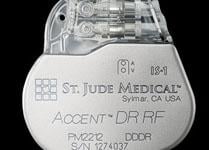
May 14, 2009 - St. Jude Medical Inc. yesterday announced European CE mark approval of its Accent RF pacemaker and Anthem RF CRT-P (cardiac resynchronization therapy pacemaker).
The Accent and Anthem product family features RF telemetry that enables secure, wireless communication between the implanted device and the programmer used by the clinician, making it the first integrated system of pacing devices with wireless telemetry from implant through follow-up. Wireless communication is used when clinicians implant the device and during follow-up appointments, which can be performed in the office or via remote monitoring with the patient at home, allowing for more efficient and convenient care and device management.
The remote monitoring capabilities facilitated by the Accent RF and Anthem RF device product line will permit automated follow-up, and daily device safety checks with no patient action required. In addition to giving physicians fast access to device performance data, the wireless monitoring system will also allow physicians to compile a more complete patient record by easily transferring cardiac device data into electronic health records (EHRs).
“Device implants and follow-ups are performed more quickly and easily with the wireless technology available in these devices,” said Johannes Sperzel M.D., from Kerckhoff Klinik in Bad Nauheim, Germany.
To better assist physicians in accurately diagnosing and managing patients with fast rates in the heart’s upper chambers (atria), the devices will also include a new AT/AF Alert feature. This feature is designed to notify physicians when a rapid atrial rate (atrial tachycardia/atrial fibrillation, or AT/AF) exceeds a programmed value or occurs over an extended time period. The devices also can be programmed to notify the patient of AT/AF episodes, as well as device- and lead-related issues, through a two-tone audible alert. In addition, the patient’s clinic can be informed through the home monitoring system. These features will allow the physician to more proactively manage patients’ atrial arrhythmias, such as AF, with appropriate medication or ablation.
“The wireless communication automates patient home monitoring, as no patient interaction is required for data transmission. Diagnostic data and alerts can be transmitted automatically to the clinic, providing me with more timely notification of clinical events and better patient care,” said professor Karlheinz Seidl, M.D., from Klinikum der Stadt Ludwigshafen, in Ludwigshafen, Germany.
In addition, St. Jude says the Anthem RF CRT-P and Accent RF pacemaker include advanced automatic features that help to promote patient safety and efficiency for the clinician. The devices can be programmed to automatically monitor and adjust the level of electrical energy needed for stimulating the patient’s heart, in the chambers where therapy is delivered; this includes up to three chambers for cardiac resynchronization therapy. The devices do this by measuring the heart’s reaction to electrical stimulation from the device and confirming that the heart is responding to the stimulation. This AutoCapture Pacing System feature provides the dual benefit of added safety for the patient and increased efficiency for physicians, as vital threshold tests are performed automatically and results are available to the physician for review on-demand during follow-up via a simple device interrogation. The launch of the Accent RF and Anthem RF devices marks the first time that these automatic test results can be accessed remotely or wirelessly in a clinic for a complete pacemaker family, including a CRT-P, and single- and dual-chamber models.
The devices are also equipped with the St. Jude Medical QuickOpt Timing Cycle Optimization feature. QuickOpt Timing Cycle Optimization can recommend the optimal A-V (atrial-ventricular) and/or V-V (ventricular-ventricular) timing values, depending upon device model, to use in programming the devices. Optimized timing can increase the efficiency of the heart’s ability to pump blood to the body. Traditional echocardiography (echo), while considered the gold standard for optimizing devices, is expensive and time-consuming. QuickOpt Timing Cycle Optimization produces results clinically proven to be comparable with those of echo, in 90 seconds instead of the 30 to 120 minutes required for a typical echo.
For more information: www.sjm.com


 May 04, 2020
May 04, 2020 

